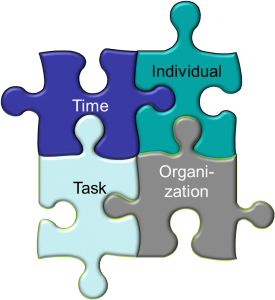When projects get into crisis situations, several factors are usually responsible in an ominous mélange. This makes it difficult to “spot” these root causes and then address them in a targeted manner.
After more than 30 years of project experience and now over 20 years of practice as the Project Doctor, I have a certain amount of practice in this, especially an eye for where things are stuck. And that’s why I’m quite quick to find suitable countermeasures. My analysis rarely takes longer than 3-4 weeks.
According to this, there are 4 different scenarios for how my clients can deal with my stabilization and improvement suggestions:
1. Take note of my analysis with gratitude and continue as before
My audit results do not always “taste” to everyone involved. They are independent and impartial, but also mercilessly honest. No one person is “to blame” for the crisis alone, but sometimes some have a more or less large share in it. And then a corresponding part of the work with the restructuring measures comes to them. Not everyone always likes to go along. Especially if one of them even benefits from the imbalance.

If the steering committee cannot agree to follow my recommendations, then that’s it. But that is not really an option that will lead to the stabilization of the project. Because it is not possible to get out of the problems that led to it with the same methods (to paraphrase Albert Einstein).
2. Give my to-do list to the internal project manager for implementation

This can work and reduces my consulting costs like Alternative 1 to the crisis analysis. In this case, however, the internal project manager must also be given the competence to demand and maintain what is necessary to carry out the recovery measures. And he must be up to the crisis job, methodically, practically and with the necessary conflict resolution and leadership qualities.
In fact, internal colleagues keep confirming to me that I receive things in a timely manner that they have been fighting for months without success because they are supposedly too expensive. The prophet counts for nothing in his own country, that is well known, but if my analysis brings about such insights and concessions to effective problem solving among the decision-makers, then I have a good feeling, provided that they have a competent internal project manager.
3. Let me coach the internal project manager to success
In more than half of my restructuring mandates, this is the option of choice. There are several reasons for this: What you have least in a recovery is time. The internal project manager knows the project, the team, the objectives and tasks, the stakeholders and the “situation mix”, which I would have to familiarize myself with for some time. I can take this time during coaching, and we still achieve sufficient effectiveness in problem solving right from the start.

As a coach, I can fill existing project management gaps, am a sparring partner and advisor, support the internal colleague vis-à-vis stakeholders and the executing organization, and am an eye and ear for risks and side effects. However, I do not take on any direct project accountability, distribute homework and keep or adjust it. As a result, my effort is usually limited and my costs for the customer are lower, without any loss of quality or effectiveness.
Positive side effect: The internal colleague and, if necessary, the executing organization also learn from me to become more mature in its project management and thus more crisis-proof.
4. Replace the internal project manager with me
Sometimes, however, it also happens that the internal project manager has been lost or needs to be replaced. This is unfortunate insofar as the time advantages of option 3 do not come into play and my engagement requires a higher commitment, at least in the first weeks and months, sometimes 24/7, until the project runs in more stable waters again.

The project and the advised company receive my full support for this from the very beginning; I take over the operational responsibility and only hand it over when an internal project manager has been found who can successfully complete the project. Even then, I will be happy to continue to be available as a coach in an advisory role.
Conclusion:
Of the 4 alternatives, only the last 3 are really an option to save projects in distress or even emergencies. But these are always significantly cheaper than Alternative 1, which usually only continues, and in the end potentially even writes off the ongoing, too high costs without any prospect of improvement. It’s as if you haven’t taken advantage of any restructuring advice in the first place.
All 3 other options successively save the opportunity costs and, on top of that, secure the business benefit for which the project was once set up.
Please also visit my corresponding Project Recovery offering














 Four major root causes
Four major root causes In one of my case studies (
In one of my case studies ( If you want to lead a project successfully you need, similar as in other professions, a good, methodical education which includes recognizing the specific project situation’s requirements and reasonably applying the adequate tools and techniques situatively and virtuously. That’s at project management like with craftsmanship where you find trainees, advanced and masters.
If you want to lead a project successfully you need, similar as in other professions, a good, methodical education which includes recognizing the specific project situation’s requirements and reasonably applying the adequate tools and techniques situatively and virtuously. That’s at project management like with craftsmanship where you find trainees, advanced and masters. Therefore a good project manager would not have undergone flaws like in our case because he would have taken care for a clear target and task definition from the start, and would have requested his superiors’ support consequently – for the sake of his project and himself. His planning would have based on realistic assumptions, and he would have identified and escalated risks and deviations and initiated counter measures early.
Therefore a good project manager would not have undergone flaws like in our case because he would have taken care for a clear target and task definition from the start, and would have requested his superiors’ support consequently – for the sake of his project and himself. His planning would have based on realistic assumptions, and he would have identified and escalated risks and deviations and initiated counter measures early. To achieve he also needs another skill: leadership qualities. He is his project’s manager, responsible for the result, and he must steer his team and his superiors so that each one contributes his part to the whole. Not an easy task, in particular if the company doesn’t work project affine. And not everybody is the person for a leadership role, feels well in it. But if he takes his job serious he will apply project management including leadership consequently. Otherwise he will soon become a scape goat if the project fails. Not a very motivating perspective, or a subject for opportunistic PM nomads who sometimes call themselves project managers…
To achieve he also needs another skill: leadership qualities. He is his project’s manager, responsible for the result, and he must steer his team and his superiors so that each one contributes his part to the whole. Not an easy task, in particular if the company doesn’t work project affine. And not everybody is the person for a leadership role, feels well in it. But if he takes his job serious he will apply project management including leadership consequently. Otherwise he will soon become a scape goat if the project fails. Not a very motivating perspective, or a subject for opportunistic PM nomads who sometimes call themselves project managers… Another frequent factor for troubled projects is time. I don’t mean the duration granted to the project for execution. This actually should always be sized realistic, not determined by wish thinking or arbitrarily. That means it must be based on realistic estimates done by the executing team members and taking the interdependences and frame conditions into account. Therefore “duration” falls into the category “Individual” for me, i.e. that the project manager does a competent job.
Another frequent factor for troubled projects is time. I don’t mean the duration granted to the project for execution. This actually should always be sized realistic, not determined by wish thinking or arbitrarily. That means it must be based on realistic estimates done by the executing team members and taking the interdependences and frame conditions into account. Therefore “duration” falls into the category “Individual” for me, i.e. that the project manager does a competent job. In fact many statistics, e.g. the one at
In fact many statistics, e.g. the one at  So the predominant part of project issues arises out of an insufficient support from the executing organization, which in turn is founded in the project culture, the management’s and established organization’s mindset.
So the predominant part of project issues arises out of an insufficient support from the executing organization, which in turn is founded in the project culture, the management’s and established organization’s mindset.

 communication and coordination.
communication and coordination.